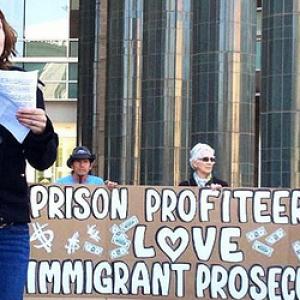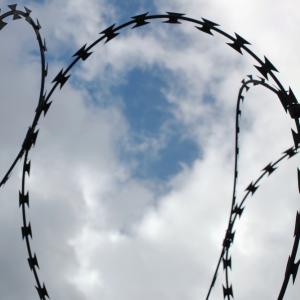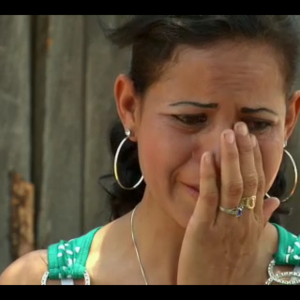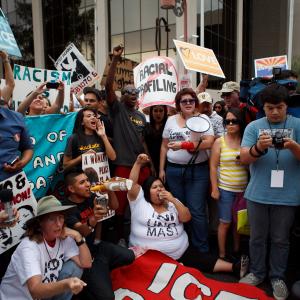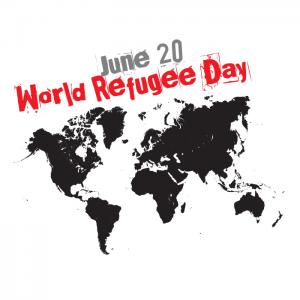
Maryada Vallet, originally from Arizona, has kept busy as a border humanitarian, health professional, catholic worker and activist on the US-Mexico border since 2005. Most recently, Maryada has worked with World Vision International in humanitarian response, with her alma mater Azusa Pacific University as an adjunct, and as a consultant for international organizations. For more on US-Mexico border humanitarian work and faith-based principles for immigration reform :www.nomoredeaths.org.
Posts By This Author
Why I Chained Myself to a Deportation Bus
On Oct. 11, I spent the morning under the front wheel of a bus filled with shackled immigrants. I joined this action with other community members to stop the two Homeland Security buses (operated by private contractor Wackenhut) from making it to the Operation Streamline proceedings at the Tucson federal courthouse. The buses were held and the front gate of the courthouse blocked for more than four hours, and Operation Streamline was ultimately cancelled for the day.
As my arms were locked around the wheels of the bus, I felt baptized into a deeper spirit of solidarity than I have ever known. Every one of the more than 70 immigrants on board those buses was shackled around their wrists and ankles. They were treated as if they were the biggest threats imaginable to our national security. During the action, the immigrants on the buses lifted their chains up to be seen through the darkened windows, and some of them put their palms together in front of their faces in a gesture of prayer and recognition of the meaning of the action. Other protestors at the scene had made signs in Spanish to communicate with the immigrants, with messages of: "Your struggle is our struggle;" "We are here defending your rights;" "You are not alone;" "We are with you, keep fighting;" "To desire a better life is not a crime."
One Courageous Act May Ignite Us All: The DREAM 9
What can be accomplished in just 10 days by the courageous actions of young immigrants? More than many of us would hope to accomplish in a year, or a lifetime. It has been more than a week since the nine DREAMers arrived at the U.S.-Mexico Nogales port of entry on July 22 and asked authorities to let them come back home. They were willing to risk all they have gained to fight for immigrant families that have been torn apart by the 1.7 million deportations by the Obama Administration.
In just over a week, these courageous young immigrant leaders have received widespread national attention. Tens of thousands of calls and letters from supporters and organizations around the country have called for their release, including the U.S. Jesuit Conference. Multiple protests and sit-ins by nationwide members of the National Immigrant Youth Alliance have included the parents and family members of the DREAM 9, gathering support from members of Congress. Just recently, Rep. Luis Gutierrez (D-Ill.) made a floor speech in the House and nearly 40 other house members have signed a letter to President Barack Obama urging him to take immediate action and use his discretion for their release.
Bordering on the Truth
Where the U.S. meets Mexico, rhetoric often gets in the way of the facts.
DURING CONGRESS’ current debate about immigration reform, the realities faced by immigrants and border communities are all too often misunderstood and misrepresented. What are the facts about border issues?
Myth #1: Border walls are effective for keeping out unauthorized border crossers.
Reality: History teaches us that walls don’t work when economic opportunity is on the other side—but walls that are higher and longer do cause more injuries and death when people are forced to go over, under, and around.
The most recent era of migration across the southern U.S. border was caused primarily by economic factors, as the North American Free Trade Agreement (NAFTA) caused millions of Mexican farmers to lose their livelihoods. The current border strategy, enacted hand in hand with NAFTA, envisioned deterring economic refugees by intentionally funneling migration to dangerous desert areas. The danger and death happened; the deterrence didn’t. It was the U.S. economic downturn, much more than the wall, that has caused the current net-zero immigration rate.
Laying Under a Border Patrol Truck — An Act of Love and Resistance
On a beautiful Sunday afternoon just a few weeks ago, a friend of mine courageously crawled under a Border Patrol truck. And he wasn't changing the oil. Raúl Alcaraz Ochoa was riding his bike to work when he came upon a scene that is all too common in southern Arizona, where racial profiling by the Tucson Police Department is permitted through the notorious legislation SB1070 and Border Patrol roam our streets. Multiple police cars and Border Patrol trucks were surrounding a vehicle apparently pulled over for traffic violation. When Raúl arrived, he saw five children crying for their father and a pregnant woman sitting terrified in the vehicle. Handcuffed and being transferred to Border Patrol custody was a Latino man named René.
Raúl had to think and act quickly, and he crawled under the Border Patrol truck. He began sending texts that spread quickly throughout a community protection network designed to alert community members and advocates about raids, abuse, and racial profiling by immigration and law enforcement. Media and supporters responded within minutes, just as Raúl was pepper sprayed, Tazed, and pulled out from under the vehicle. Both men spent the night in custody, and public demands were widespread for their release. While Raúl was released the next day, top officials of Border Patrol and the Department of Homeland Security ignored pleas for René to rejoin his family, and he was promptly deported to Mexico.
Shackles, Operation Streamline, and Spokes in the Wheel
Remember those who are in prison, as though in prison with them, and those who are mistreated, since you also are in the body. — Hebrews 13:3
Where are defendants, who have committed no atrocious crimes, denied due process, shackled en masse before a judge, and sentenced during a trial of assembly-line justice? The answer: the daily proceedings in the federal courthouses of Tucson, Ariz., and a few other border locations. But anti-immigrant masterminds in Arizona did not think up this “zero tolerance” program. It is the result of powerful lobbying by private prison companies and our political willingness to harshly criminalize unauthorized migration.
Operation Streamline began in 2005 in Texas and 2008 in Arizona as part of the deterrence strategy of border enforcement. Instead of the typical civil violation, it charges people who cross the border without authorization with criminal misdemeanors (punishable by up to six months in federal prison) and then felonies (punishable 20 years) to those who return after a past deportation. Sen. John McCain, (R - Ariz.) has proposed an expansion of the program as part of immigration reform.
But according to a recent report, the federal government already has spent an estimated $5.5 billion incarcerating undocumented immigrants in the criminal justice system for unauthorized entry and re-entry since 2005. Unauthorized entry/re-entry have recently become the two most prosecuted crimes in the entire federal judicial system. Consequently, Latinos now represent more than 50 percent of all those sentenced to federal prison despite making up only 16 percent of the U.S. population.
Border Security Before Citizenship is a Bad Idea
Last week a group of senators released principles for immigration reform that would make the path to citizenship for over 11 million immigrants contingent upon more border security.
That is simply a bad idea. It binds together immigration and threats to national security as one in the same. This mindset should be questioned and rejected, and, even more, it infringes upon the heart and soul of Christianity — to boldly love thy neighbor.
Been There, Bordered That. So Why Are We Still So Afraid?
The Angels of Advent are saying, "Do not be afraid" -- we bring good news of immigration reform.
And what does fear do to us?
We disregard the good news at our doorstep, the opportunity to live with Jesus among us, and keep on building walls at our threshold. Perhaps that's why the angels of the Bible repeat this admonishment -- Do not be afraid -- over and over again, for fear inhibits our ability to see and hear a new vision.
I remember as a child wanting to leave the lights on in my room at night. The shadows and sounds were too much for an imagination that could run wild to handle. As adults, of course, it's our duty to assure children that nothing is living in their closets or under their beds. We offer the comfort of reality so that the child will go to sleep and have sweet dreams.
But you have to admit, as adults we are gripped by the same fear but on a different level. We may compulsively check to make sure the front door is locked. We don't look strangers in the eye (especially those we deem to look "strange") as we pass them on the street.
Border Violence is Fast & Furious; Four Killed in Recent Weeks
Candles burn near the bloodstained concrete sidewalk where a youth was tragically killed when more than a dozen bullets shot across the wall into the Mexican bordertown. I've walked that sidewalk running parallel to the border wall and Calle Internacional in Nogales, Sonora possibly hundreds of times. It is with this intimate awareness of the context that I describe how recent deaths in the name of homeland security are an affront to all families of the borderlands.
Four deaths in six weeks across the border region, one common offender
On the evening of Oct. 10 U.S. Border Patrol agents shot and killed 16-year old José Antonio Elena Rodriguez. The shots were fired through the paneled border wall in Nogales hitting José Antonio in the back seven-to-eight times. The agents allege the boy was involved in rock throwing. For more detailed description of the circumstances, see this article.
About a week earlier, Border Patrol agent Nicolas Ivie, 30, was killed in Naco, another Arizona border town just east of Nogales, when a fellow U.S. agent searching for smugglers mistakenly opened fire. Agent Ivie has a wife and two young daughters who live in southern Arizona, and the family is publicly fundraising to survive without him.
How Do You Call the Cops on the Cops? Sobering Accounts of Abuse by Border Patrol
What would you do if you were offering a voluntary service, like medical or pastoral care to a vulnerable population, and the clients repeatedly spoke of abuses by a specific perpetrator? You would be a “mandated reporter,” which for the caring professions means you must report certain cases of abuse to authorities. But then you find out that federal employees—law enforcement, in fact—are committing the atrocities. How do you call the cops on the cops?
This was my dilemma as I started working on the Mexico-side of the Sonora-Arizona border washing blistered feet and bandaging wounds of migrants who were just repatriated back to Mexico.
We set up the Nogales Migrant Aid Station to provide basic care to upwards of 1,200 deported people each day. But we did not expect that human rights documentation would become the most pressing part of that work. With each Homeland Security busload of migrants being released from Border Patrol custody, we listened and then documented case after case of abuse.
The abuse involved cussing and yelling, being pushed into barbed wire fencing, sexual assault, denial of life-saving medical care, denial of adequate food and water to children and the list continues.
But It’s a Dry Hate: The Human Spirit of Arizona Will Not Be Broken
Even at 10 p.m., the dry heat caused the collapse of multiple people of faith gathered in a candlelight vigil outside Sheriff Joe Arpaio’s infamous tent city jail on Saturday evening. Earlier in the day, nearly 120 miles due south of Phoenix, the bodies of three immigrants who died of heat stroke were found. In one of those cases of tragic death, the man who collapsed was Guatemalan and his pregnant wife sat by his side.
Arizona continues to lead the way in the border humanitarian crisis and with immigrant rights violations. As a humanitarian, ally, and advocate, I came to the migrant justice movement with the belief that the U.S. immigration system and border policies were merely broken, but I am convinced now that these violations of human dignity are the symptoms of systemic racism targeted at immigrants.
The system is not broken, it is meant to break people.
World Refugee Day 2012: Redefine Who Deserves Refugee Protection from Christian Communities
Who is a refugee in our world today? How does one receive “refugee protection” and is this determination fair and just? On World Refugee Day 2012, June 20, we remember those who have fled persecution because of their ethnicity or country of origin, religion or political views.
These atrocities are serious and asylum an appropriate response. The UNHCR reports that 800,000 people became refugees in 2011, while a total of 4.3 million people became newly displaced (mostly hosted in Africa and the Middle East).
